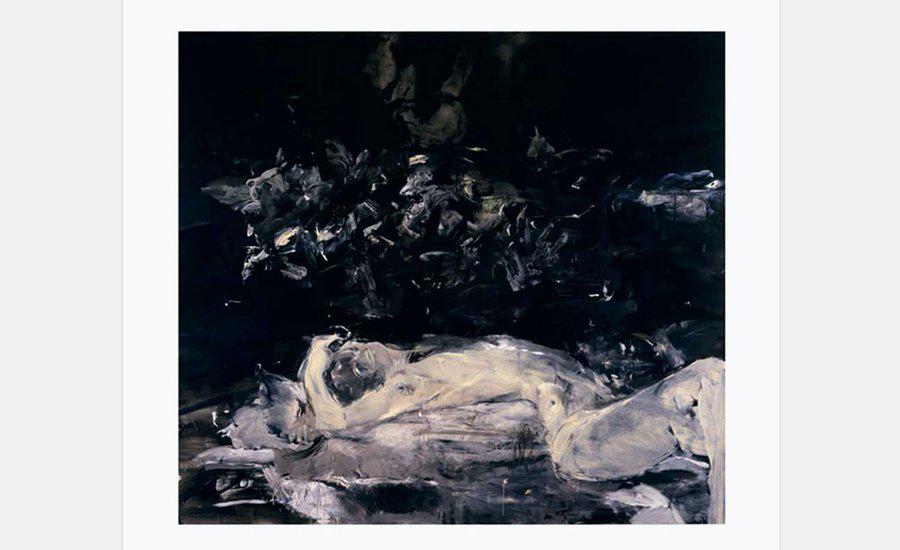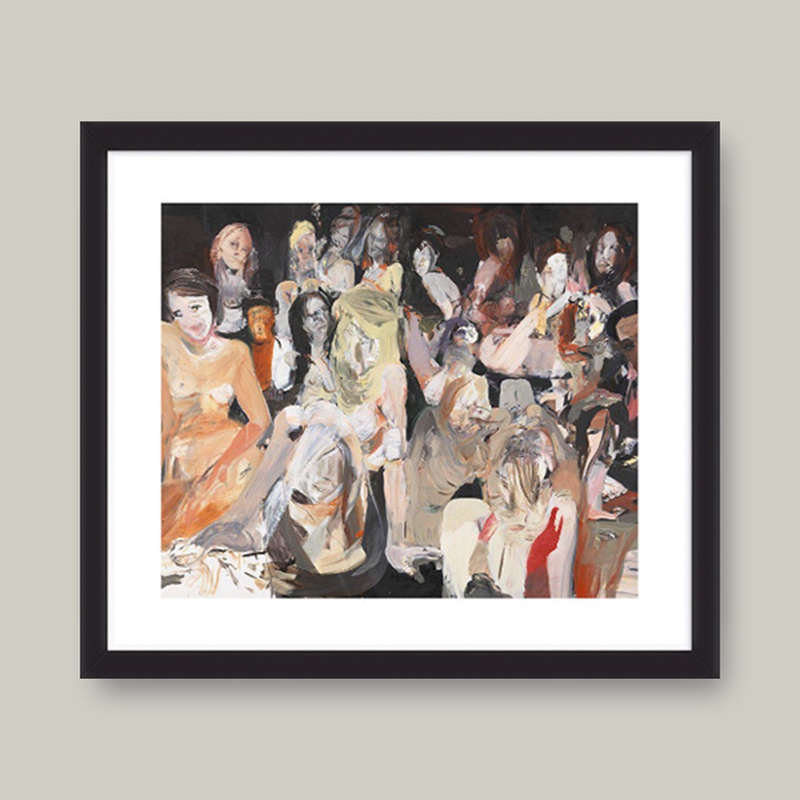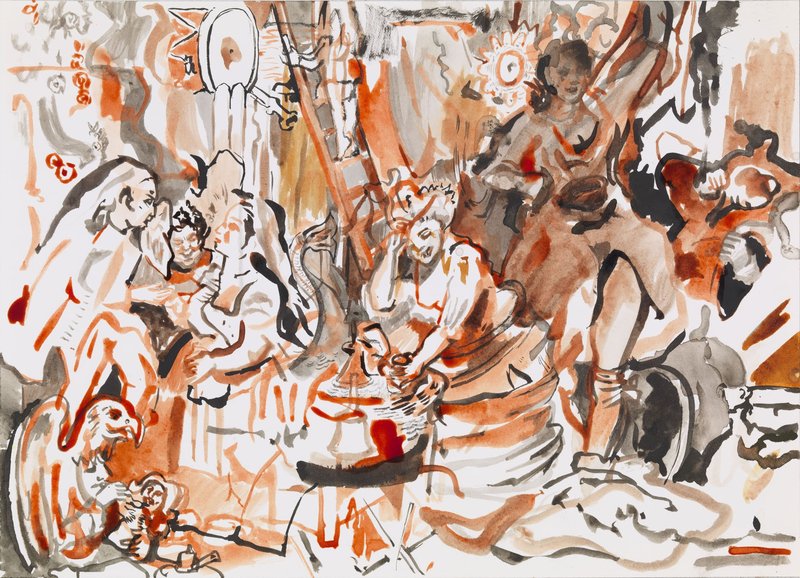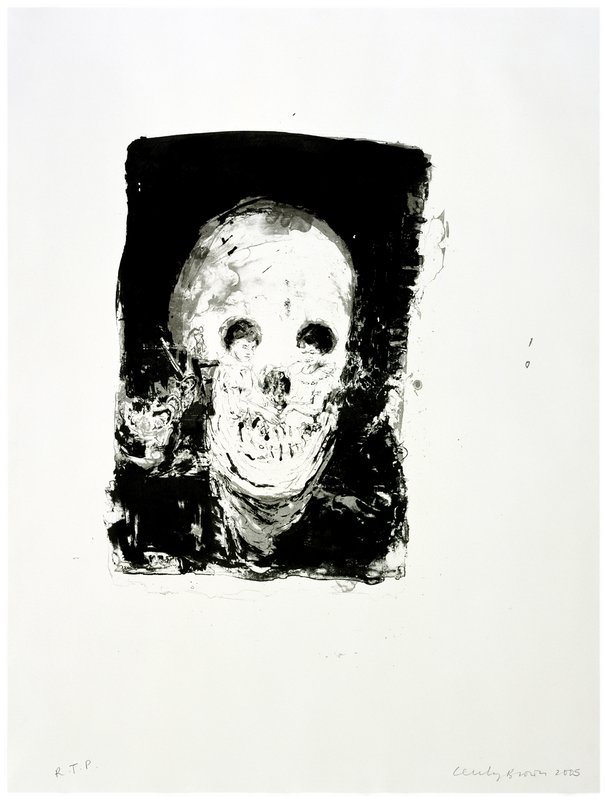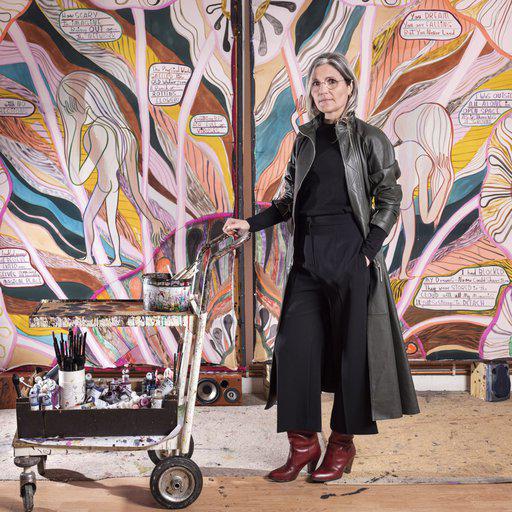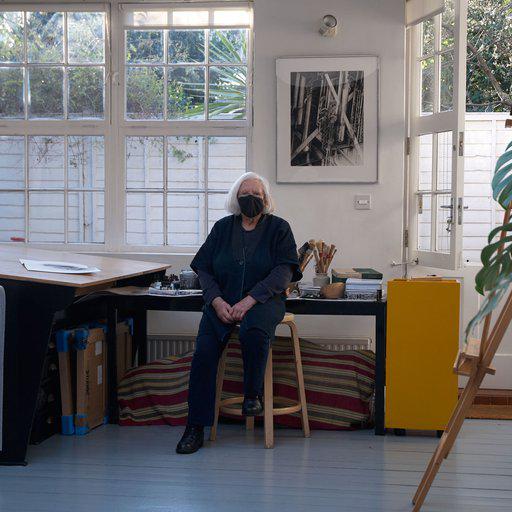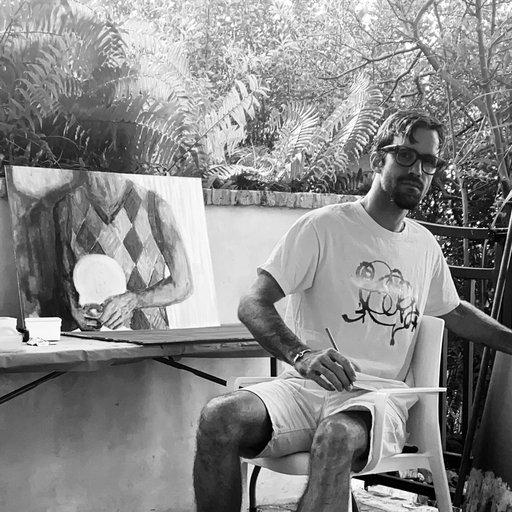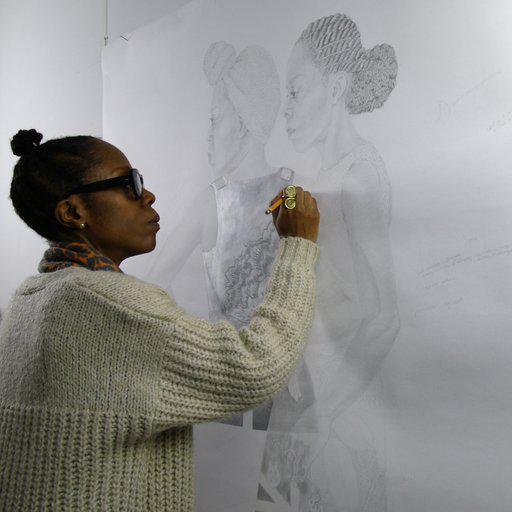Back in 2002, the British-born, New York-based, painter Cecily Brown began a new series of canvases - now known as the Black Paintings. In each of the works, there is a recumbent nude on a bed, usually with the figure's head at left, and the body parallel to the picture plane.
“Gravity presses her down into the lower third of the composition, and the upper two thirds are dominated by a black sky," writes Jason Rosenfeld in Phaidon’s Contemporary Artist Series book on Brown . The respected art-history professor compares the break-up of the canvas to Dutch Golden Age landscapes of the seventeenth century, and Romantic Age of Revolution works such as Jacques-Louis David’s The Death of Marat (1793).
Brown’s paintings demonstrate a unique combination of abstraction and figuration, transcending classical notions of genre and narrative, by drawing on a wide range of art historical references. Variably inspired by the fantastical visual worlds of Bosch and Goya, the organizational principles of Hogarth, and the gestural expressionism of de Kooning, Cecily Brown creates energetic and atmospheric canvases that often swirl with fragmented bodies.
Cecily Brown has been based in New York since the 1990s, when she rose to prominence as a leading figure in the contemporary painterly canon. Her work is included in public collections including: the Guggenheim, the Whitney and the Brooklyn Museums in New York; the Louisiana Museum, Denmark, the National Gallery of Norway, the Tate Gallery, London, and the Foundation Louis Vuitton, Paris.
Her summer 2020 exhibition at Blenheim Palace in Great Britain received rave reviews, while her late 2020 show of what she refers to as 'bedroom paintings' created during lockdown, at Paula Cooper Gallery met with equally high praise; though these paintings due to their size, and the conditions they were created under, were, she tells Artspace, " Some of the most difficult I’ve made in a while."
In this interview, conducted to coincide with the release of a
Cecily Brown Phaidon/ Artspace print
Black Painting 1
(2020)
, and accompanying limited edition Contemporary Artist Series book, the painter reflects on her personal motivations underlying this body of work, and explains why she chose the veryfirst work from the Black Paintings for this new edition, before going on to offer a few placement suggestions for any lucky buyers of the edition.
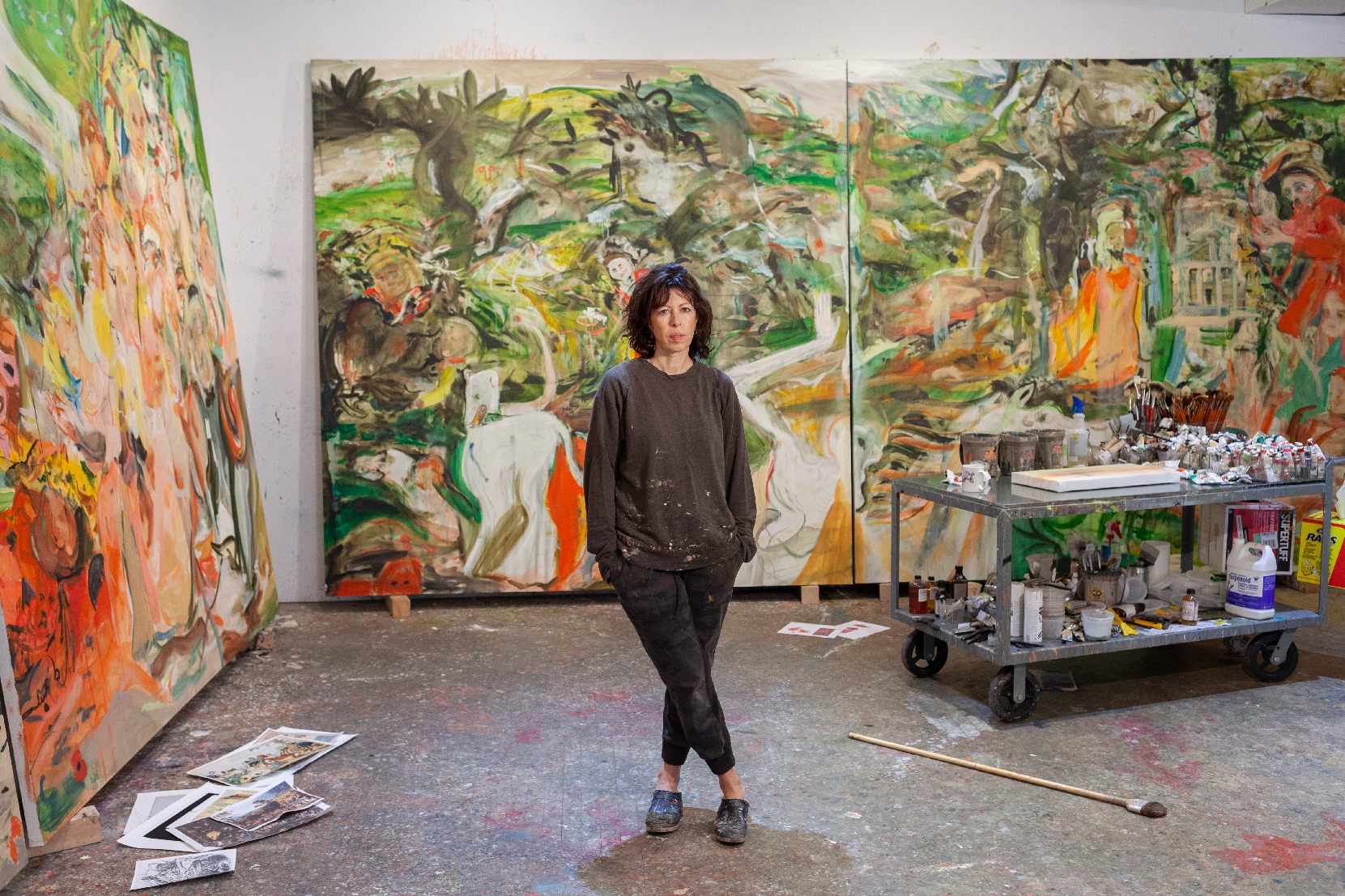 Cecily Brown, New York, 2020. (c) Cecily Brown Photo by Danna Singer
Cecily Brown, New York, 2020. (c) Cecily Brown Photo by Danna Singer
Why did you choose Black Painting 1 for this Phaidon/Artspace edition? The older I get the more I dig into my own past, and use my own work as a source for new work. Sometimes you see something and you think, oh I’ve never really fully explored that, and there’s more territory for me to dig into. And that’s how I’ve felt recently about the so-called black paintings. I’ve never done a black painting as a print before and they’re such an important body of work for me.
Where do editions fit into your practice?
I’ve started thinking of digital prints as a new corner of my work. It’s so great to be able to do something relatively affordable that more people can have. Also, the quality of digital printing has got so good. Honestly, it’s almost as good as the original. It’s only when you look very close up that you see the difference.
How did the Black Paintings originally come about?
Around the early 2000s, my paintings had become more and more abstract and very colorful, and I wanted to really reduce the palette but also reduce the imagery and force myself to make a more clear, graphic image that was more legible. So it was a question of pulling the figure back in. So the first Black Paintings came out of formal needs of mine to not use every color in the universe and only use black and white, and maybe one other color...
What was the source for the Black Paintings?
The source was something I’d drawn from a lot, for years - late 19th century erotica. The image came from a book of erotica I’d had since the 1990s. I’d always been struck by this image of the supine nude - male or female - often androgynous. And often with a dream or kind of nightmare above them. It’s very romantic and harks back to (Henry) Fuseli and the Victorian painters.
But the word 'black' has changed in the last couple of years and it feels weird to me as a white woman to call them Black Paintings when they are of white figures. I’m not going to go back and change the name of the early ones - they will still be called Black Paintings -but I don’t think I’m going to use the title 'Black' going forward. I’m going to change the names of them to Night Paintings, or Shadow Paintings.
 Cecily Brown's signature on the reverse of the edition and in the accompanying Phaidon book
Cecily Brown's signature on the reverse of the edition and in the accompanying Phaidon book
So it’s very much an ongoing series?
Yes, it comes back in different ways. I got back into using black again after looking at Max Beckmann a few years ago and reading that he had a whole palette just for blacks. His blacks are amazing. I think I use black as a palette cleanser, but with nearly all my work I feel like there’s a constant paradox going on. If there’s too much color I want to pare it down, if there’s too much abstraction I want to bring back the figure. If it goes in one direction I tend to want to do something else. So I’ve always got my work cut out for me.
Would you say the sexual aspect of your work is more dominant in those Black Paintings?
Well it’s more blatant in these paintings, in my earlier paintings. . . there was never a single figure. From very early on I always had at least two figures and often many more. The paintings I first showed in New York were basically orgies - with many figures entangling. It wasn’t always clear who was who. I think these are more autoerotic. And I think that’s another reason I go back to them but I want to - not say something - but have them encompass something about female sexuality and the autoerotic.
I always felt that I had an advantage when looking at female nudes by old masters - because I could be in the shoes of both artist and subject. As a woman, you know what it 'feels like' to be coming from within the painting – you’re the one thing that’s always being viewed. It sounds fanciful but it’s as if you are the woman. You see a Venus of Urbino lying down and you’re like, 'oh yeah, I know how the weight of that elbow feels.'
But you never wanted your work to be seen as autobiographical?
Being a woman and painting quite charged subjects, I never wanted people to think it was me in the paintings. But looking back they seem far more personal than I was willing to concede at the time. I think it’s so problematic with the female nude, and being a female, and so being used to being looked at while also being a ‘looker’ – looking at things. When I was younger I never really had a problem with how many naked women there were in museums, and that they were all by men - I just liked being in museums and I didn’t really think like that.
But early on, as a woman painting the female nude, I had a lot of reviews that assumed it was me. It was quite offensive, and there was a lot of criticism of my work that was very personal, and so I think I always resisted that idea and thought I don’t want to put myself in the paintings blatantly. It’s not about my life. Maybe that’s why I use art history as a kind of distancing device - (i.e.) it’s not me, it’s a comment on Danaë or Goya.
So do you think with this image and edition you see more of yourself than you perhaps did before? Yes, yes I do. I mean, it’s supposed to be a kind of everywoman figure. An archetype. The criticism I had of them at the time was they’re very much a trope. You know how this works; you can’t really fail. A lot of them [the Black Paintings] came from the 19th century drawings that I was copying - extraordinary things - a huge ejaculating phallus, little fucking figures in the air, vaginas and winged penises – just this extraordinary cornucopia of sexual imagery.
I copied all those erotic drawings so many times and they were what I was thinking of when I did the dreamlike ethereal substance above the figure [in the Phaidon/Artspace print]. I was also thinking about the horrors - Billy Wilder’s The Lost Weekend where the man drinks so much that he has these black bats coming at him in the night. And it also relates to Goya’s Sleep of Reason Produces Monsters. Having both the figure and the tangible atmosphere around her is a way of being abstract and figurative in the same space. It’s as if there’s another ‘her’ exploded in the ether - there’s something ghostly about it. It looks like it’s her, or atoms of her.
You’ve reached that point in your career where you really can do absolutely anything or, conversely, become paralysed by expectation. How do you deal with that? I think I just blindly paint! I think that you just have to get on and make the work if you’re a visual artist and critique it later. And of course there’s a constant critique going on in your head as you’re doing it. I could easily talk myself out of doing this if I didn’t physically enjoy it so much and find it so compelling and interesting after all these years.
And you are prolific. . . I’m prolific, but I edit a lot. So one good thing about being in my position, and being solvent, is that I don’t have to sell even half of what I make, so I don’t feel pressured in that way. It’s a luxury. I can keep things so it’s just all a big work in progress. You always keep learning.
Still ambitious too then! I am horribly ambitious. Just in the last few weeks I’ve been painting with a technique that’s new and different for me. I often think that I’m just getting started. Intellectually I think this is why I struggled so much in the early nineties. I know better intellectually than to be painting a painting after a Dutch still life master but, in the end, I think it’s all about wanting to have that dialogue with other paintings.
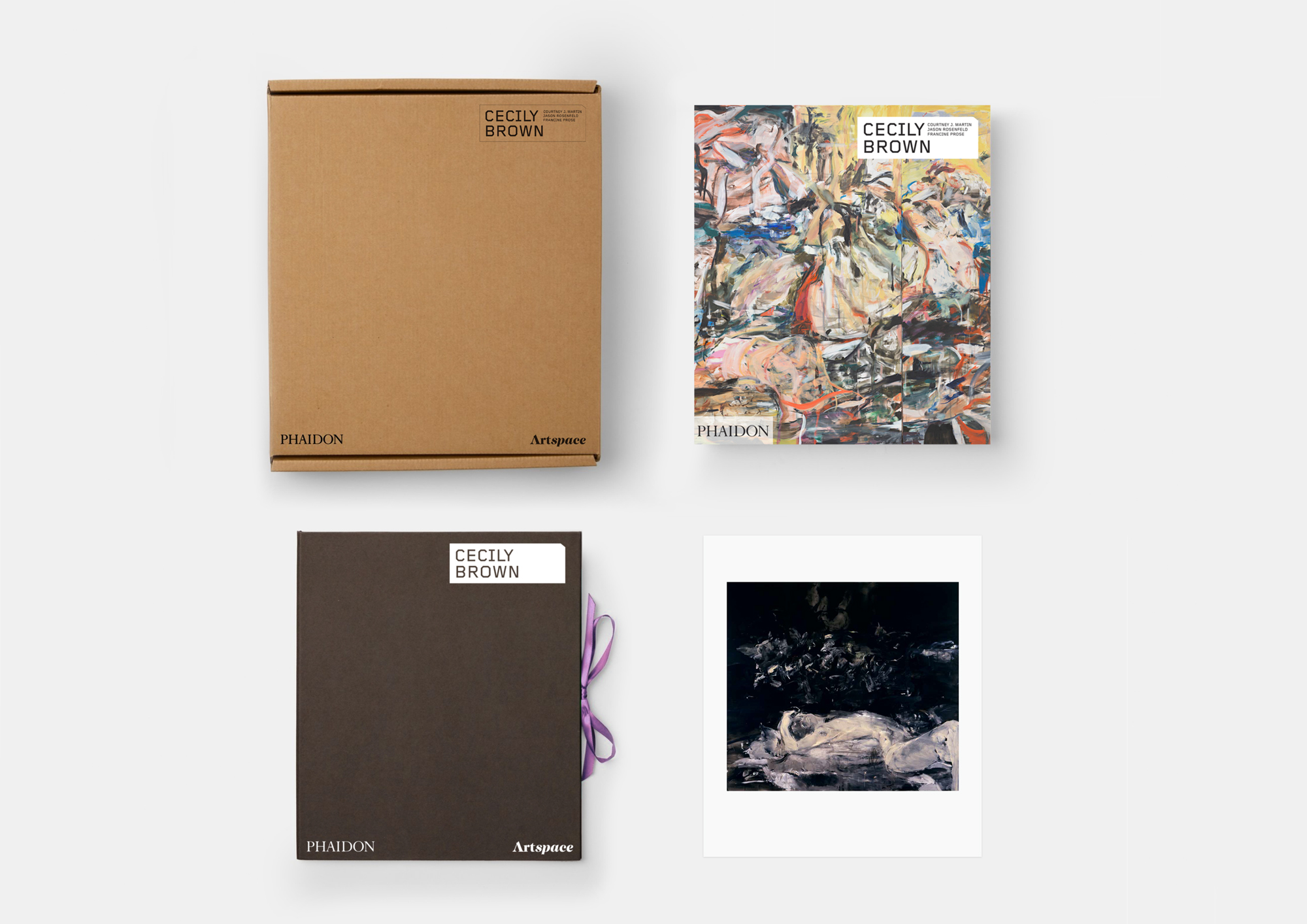 The Cecily Brown Phaidon/ Artspace limited edition box, book and signed print
The Cecily Brown Phaidon/ Artspace limited edition box, book and signed print
What have you seen lately that opens up that conversation, that dialogue?
I saw a Frans Snyders painting in person the other day. I’ve been working from reproductions of his works for a couple of years and I’m so obsessed with him and now I’m just trying to hold those brushstrokes I saw in my head. Snyders work is as completely alive today as the day it was painted. You look at a painting and the presence of the time it was made is still there. Embedded in the oil.
Do you have any advice for where buyers lucky enough to get a copy of this edition may like to hang it?
I think you want to put a print like this in a super simple frame. It would look nice either by itself or in a salon style. I think it’s a very intimate subject so it’s like a bedroom painting to me. It would obviously work in a bedroom because it’s ‘of the night’. But I think they work anywhere.
It’s nice seeing things in domestic settings, not too precious. Even leaning on a mantelpiece, with a vase of flowers and little objects. I like leaning things on mantelpieces and shelves. That’s the nice thing about a print, it’s quite informal.
The signed print Black Painting 1 (2020) is accompanied by a signed copy of Phaidon's Contemporary Artist Series monograph on Cecily Brown in a presentation box, strictly limited to 50 copies. Available here.











